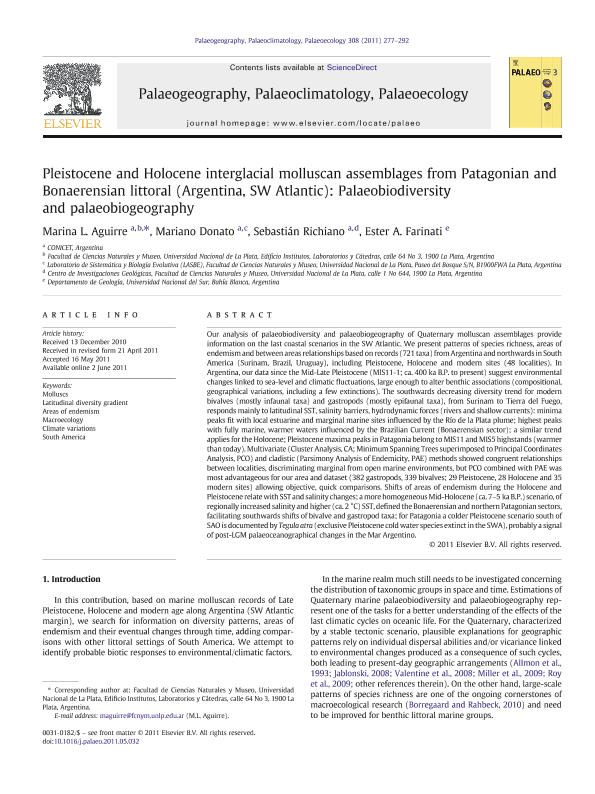Artículo
Pleistocene and Holocene interglacial molluscan assemblages from Patagonian and Bonaerensian littoral (Argentina, SW Atlantic): Palaeobiodiversity and palaeobiogeography
Aguirre, Marina Laura ; Donato, Mariano Humberto
; Donato, Mariano Humberto ; Richiano, Sebastián Miguel
; Richiano, Sebastián Miguel ; Farinati, Ester Amanda
; Farinati, Ester Amanda
 ; Donato, Mariano Humberto
; Donato, Mariano Humberto ; Richiano, Sebastián Miguel
; Richiano, Sebastián Miguel ; Farinati, Ester Amanda
; Farinati, Ester Amanda
Fecha de publicación:
08/2011
Editorial:
Elsevier Science
Revista:
Palaeogeography, Palaeoclimatology, Palaeoecology
ISSN:
0031-0182
Idioma:
Inglés
Tipo de recurso:
Artículo publicado
Clasificación temática:
Resumen
Our analysis of palaeobiodiversity and palaeobiogeography of Quaternary molluscan assemblages provide information on the last coastal scenarios in the SW Atlantic. We present patterns of species richness, areas of endemism and between areas relationships based on records (721 taxa) from Argentina and northwards in South America (Surinam, Brazil, Uruguay), including Pleistocene, Holocene and modern sites (48 localities). In Argentina, our data since the Mid-Late Pleistocene (MIS11-1; ca. 400. ka B.P. to present) suggest environmental changes linked to sea-level and climatic fluctuations, large enough to alter benthic associations (compositional, geographical variations, including a few extinctions). The southwards decreasing diversity trend for modern bivalves (mostly infaunal taxa) and gastropods (mostly epifaunal taxa), from Surinam to Tierra del Fuego, responds mainly to latitudinal SST, salinity barriers, hydrodynamic forces (rivers and shallow currents): minima peaks fit with local estuarine and marginal marine sites influenced by the Río de la Plata plume; highest peaks with fully marine, warmer waters influenced by the Brazilian Current (Bonaerensian sector); a similar trend applies for the Holocene; Pleistocene maxima peaks in Patagonia belong to MIS11 and MIS5 highstands (warmer than today). Multivariate (Cluster Analysis, CA; Minimum Spanning Trees superimposed to Principal Coordinates Analysis, PCO) and cladistic (Parsimony Analysis of Endemicity, PAE) methods showed congruent relationships between localities, discriminating marginal from open marine environments, but PCO combined with PAE was most advantageous for our area and dataset (382 gastropods, 339 bivalves; 29 Pleistocene, 28 Holocene and 35 modern sites) allowing objective, quick comparisons. Shifts of areas of endemism during the Holocene and Pleistocene relate with SST and salinity changes; a more homogeneous Mid-Holocene (ca. 7-5. ka B.P.) scenario, of regionally increased salinity and higher (ca. 2°C) SST, defined the Bonaerensian and northern Patagonian sectors, facilitating southwards shifts of bivalve and gastropod taxa; for Patagonia a colder Pleistocene scenario south of SAO is documented by Tegula atra (exclusive Pleistocene cold water species extinct in the SWA), probably a signal of post-LGM palaeoceanographical changes in the Mar Argentino. © 2011 Elsevier B.V.
Archivos asociados
Licencia
Identificadores
Colecciones
Articulos(CCT - LA PLATA)
Articulos de CTRO.CIENTIFICO TECNOL.CONICET - LA PLATA
Articulos de CTRO.CIENTIFICO TECNOL.CONICET - LA PLATA
Articulos(CIG)
Articulos de CENTRO DE INVEST.GEOLOGICAS (I)
Articulos de CENTRO DE INVEST.GEOLOGICAS (I)
Citación
Aguirre, Marina Laura; Donato, Mariano Humberto; Richiano, Sebastián Miguel; Farinati, Ester Amanda; Pleistocene and Holocene interglacial molluscan assemblages from Patagonian and Bonaerensian littoral (Argentina, SW Atlantic): Palaeobiodiversity and palaeobiogeography; Elsevier Science; Palaeogeography, Palaeoclimatology, Palaeoecology; 308; 3-4; 8-2011; 277-292
Compartir
Altmétricas



